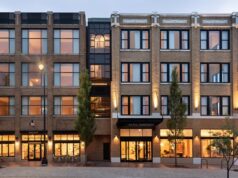Design elements cannot be overvalued in the hospitality industry. Carpet contributes to the signature impression, adding comfort to small spaces and human scale to imposing interiors. When specifying carpet for hospitality, there are three considerations to ensure sustainable selections—design and purpose; maintenance during useful life; and end-of-life options.
Where do you start and what do you ask? Fortunately the carpet industry has removed the angst from the green certification process. Now a single standard identifies carpets that have a reduced environmental impact. The first multi-attribute American National Standards Institute (ANSI) approved Standard—NSF 140-2007, Sustainable Carpet Assessment Standard was introduced at Greenbuild 2007 (www.nsf.org/info/carpet).
With NSF-140 as a guide to sustainable products and manufacturers, choose design patterns compatible with the surroundings and a carpet backing system appropriate for expected wear. Other sustainability concerns for carpet selection include Indoor Air Quality impacts; potential contributions to the LEED (Leadership in Energy and Environmental Design) Green Building Rating System; installation or down time during installation; and anticipated useful life.
Hospitality Carpet Attributes
On the surface, carpet colors and patterns support the property brand. Hospitality carpet is specifically created for different applications—lobbies, corridors, ballrooms, offices, meeting rooms, guestrooms, spas. Warranties for the selected design should include protection for antimicrobial, edge-raveling, delamination, resiliency, wear, colorfastness, lightfastness, atmospheric contaminants, flooring compatibility and loss of pattern appropriate for the intended use.
The backing system provides the foundation on which carpet performance attributes are built. Carpet backing can improve the appearance retention and durability of the product; determine the level of noise reduction; lower the likelihood of accidents and cushion against injury in the event of a fall by providing a non-slip surface; and add insulation to help control temperature and conserve energy. Products manufactured with an integrated cushion backing ensure underfoot comfort and extended appearance retention.
Here are a few questions you may want to ask when selecting your modular carpet:
• Does it contain PVC or other chemistries that may affect Indoor Air Quality?
• How long will the designs be available if replacement tiles are needed?
• What warranties are provided?
• What is the anticipated down time for installation?
• If LEED points are an issue, have we made a thorough comparison?
• What are the end-of-life options with this product?
Maintenance Considerations
Modular carpet offers disruption-free maintenance, reducing down time to help the bottom line and guest relations. One of the many advantages of modular carpet is the ability to replace a single tile rather than an entire room. Speedy turnaround is a plus for high traffic areas. Proper maintenance extends the product life and reduces the overall costs of carpet. Choosing the right long-term maintenance process for carpet and textiles can result in healthier interior environments. However, there is no single across the board solution.
A typical detergent-in-hot-water method is effective for areas with heavy grease, animal traffic or similar environments. Detergents used in wet systems create residue that can have a damaging effect on the carpet, causing rapid re-soiling, which leads to poor appearance and a shortened life. Systems using dry-polymer—either as the primary cleaning agent or as a follow-up to hot water for areas with heavy soil—are a better bet for maintaining a consistently good appearance and prolonging the overall lifecycle of textiles and carpet. They do not contribute to the growth of mold, mildew or other contaminants that can be a factor when using solely wet-based methods and require less water which drives up utility costs and negatively impacts the environment.
End-of-Life Options
The anticipated useful life of a carpet is generally five to 15 years, depending on the location. Product in administrative areas will change less frequently than in corridors. Disposal in a landfill is no longer an option and may result in fines. An increasing number of jurisdictions have passed regulatory restrictions that ban products with PVC, which includes some carpet, from local landfills.
In response to high levels of construction waste sent to landfills in the past, the carpet industry has been aggressive in providing solutions. Today Milliken and member companies voluntarily support activities to prevent carpet from burdening landfills with end-of-life solutions. Carpet America Recovery Effort (CARE) is a joint industry-government effort to increase the amount of recycling and reuse of post-consumer carpet and reduce the amount of waste carpet going to landfills (www.carpetrecovery.org). Options include renewal through a closed loop system, reuse through donations and recycling of components into new carpet or other products to avoid landfill.
Selection, maintenance and disposal represent the continuing cycle of carpet decisions. Each aspect has its own considerations. In the carpet industry, we are pleased that carpet’s product life cycle continues to reduce its impact on the environment.
Bill Gregory, Director of Sustainable Strategies for the Floor Covering Division of Milliken & Company (www.sustainablecarpet.com), has actively participated in establishing sustainable standards for the carpet industry. He represents carbon negative Milliken with the U.S. Green Building Council, the NEWH Sustainability Committee, and the board of Carpet America Recovery Effort (CARE), among other green organizations.







